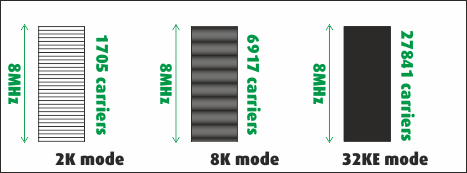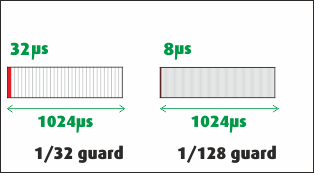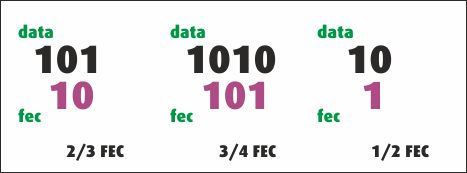Freeview modes - a simplified explanation
 Brian Butterworth published on UK Free TV
Brian Butterworth published on UK Free TV As mentioned in How digital television works Freeview signals can be broadcast in a number of different "modes", which are a combination of five parameters. Some of these have changed over the years because the increase in computing power has made more efficient methods of broadcasting cheap enough to fit in a set-top box - it is now possible to broadcast high definition television or more standard definition services on the same physical wavelength.
As some of the ideas that are implemented would fill a text book by themselves, I have presented the concepts in a simplified way.
Sub-carriers
Each Freeview multiplex is broadcast within an 8MHz channel that was originally allocated to analogue television. Rather than being a single broadcast, the channel is split into a number of different signals that sit next to each other.The original digital terrestrial broadcasts (from the launch of ONdigital) used 1,705 sub signals (referred to as 2k mode) about 4,600 Hz apart. After switchover 6,817 subcarriers (8k mode) means the signals are 1,170 Hz apart, with the high definition service using 27,841 (32ke) subcarriers just 280Hz apart.

It is possible to space carriers so close together because they are carrying digital information, in the analogue domain the problem with sidebands would render a similar system useless.
Symbol duration
For reasons detailed below, the information is not transmitted in single bits on each carrier, but as groups of bits which are referred to as "symbols". Each symbol is held in the transmission system for a given duration, 1024 us. The longer this time is, the less information is carried, but too short a duration for each symbol would not allow the receiver to detect the information correctly.Guard interval
Each subcarrier also uses a guard interval, which turns off each carrier as part of the transmission cycle. With SD broadcasts, this is 1/32th of the symbol time (32us), on HD it is 1/128th (8us). The guard intervals start each symbol and exist to deal with the problems of multipath - where the signal is being received directly and also by reflections.
Forward error correction
In non-synchronous digital transmission systems, such as those used for the internet, the presence of data corruption between the sender and receiver can be signalled back to the source and the data resent.However, a digital broadcast is a one-to-many unidirectional system, with no ability to ask for data to be resent.
For this reason, the transmissions use "forward error correction", which is a system that allows a certain level of errors to be detected.
The most basic form of a forward error correction (FEC) would be to transmit each bit twice - as long as each bit was sent along a separate subcarrier, then a single bit loss on one carrier could corrected by using the one sent on the other carrier. However, this is very inefficient, as it reduces the useful capacity of the system by half.

So, instead the DVB-T system uses a Punctured Convolution coding system. Instead of sending each bit twice, bits are grouped and then a code that describes the bits in a way that a single bit error can be detected and corrected most of the time.
Quadrature amplitude modulation
In the above descriptions, the word "symbol" was used to describe what is transmitted. You may have thought that a digital system would transmit information on the subcarriers as bits. However, doing this in a broadcast system is actually unproductive.For this reason, quadrature amplitude modulation is used. This takes the incoming bits and encodes them in groups. The most basic form encodes bits two at a time, using sine (Q) and cosine (I) functions that are then added to the main carrier. In effect "00" is encoded as -Q-I, "11" as +Q+I, with "01" and "10" being +Q-I and -Q+I.

At the next level, as used for DVB-T, the bits are encoded in groups of four bits (16QAM) or eight bits (64QAM), with DVB-T2 being groups of 16 bits (256QAM).
UK Freeview modes
There are 10 modes defined for use in the UK, these are:- Mode 1: DVB-T 1705 (2K) carriers, 64QAM mode, FEC=2/3, 1/32 guard = 24.13Mbps
- Mode 2: DVB-T 1705 (2K) carriers, 16QAM mode, FEC=3/4, 1/32 guard = 18.1Mbps
- Mode 3: DVB-T 6817 (8K) carriers, 64QAM mode, FEC=2/3, 1/32 guard = 24.1Mbps
Mode 4: DVB-T2 6913 (8KE) carriers, 64QAM mode, FEC=4/5, 1/32 guard = 34.7MbpsunusedMode 5: DVB-T2 27841 (32KE) carriers, 256QAM mode, FEC=3/5, 1/128 guard = 36.1Mbpsunused- Mode 6: DVB-T2 27841 (32KE) carriers, 256QAM mode, FEC=2/3, 1/128 guard = 40.2Mbps
- Mode 7: DVB-T 6817 (8K) carriers, QSPK mode, FEC=1/2, 1/32 guard = 6.0Mbps
- Mode 8: DVB-T 6817 (8K) carriers, 64QAM mode, FEC=3/4, 1/32 guard = 27.1Mbps
"high capacity commercial multiplex mode". Mode 9: DVB-T2 27265 (32KN) carriers, 256QAM mode, FEC=3/5, 1/128 guard = 35.2Mbpsunused- Mode 10: DVB-T2 27265 (32KN) carriers, 256QAM mode, FEC=2/3, 1/128 guard = 39.2Mbps
- Mode 11: "Northern Ireland mode" details TBC
Diagram showing capacity for each mode:

Help with Television sets?
Sunday, 16 September 2012
D
david durney3:47 PM
Clacton-on-sea
jb38 Thank You for your replies to my queries asking if a new wind farm with five 125 metre high turbines will interfere with the Sudbury signal to my home in Clacton on Sea. At present we are getting decent HD pictures on our three TV,s. As soon as these monstrosities become operational I will let you know the result, as I,m sure this must be affecting a lot of viewers all over the country as these things are appearing everywhere.
| link to this comment |
david's: mapD's Freeview map terrainD's terrain plot wavesD's frequency data D's Freeview Detailed Coverage
J
jb388:44 PM
david durney: Yes! please do, although the main problem with wind farm blade interference is the totally erratic element attached to it whereby any disruption to service that they might cause can vary from day to day, this not only because of changes in the blades rotational speed but also the fact of the blade positions on two or more turbines being synchronised with each other at certain times and not others, and of course the other factor of the situation being different again if it rains.
However only time will tell as to whether or not they will affect your particular location, as some people for some magical reason seemingly escape relatively unscathed from the effects created by these inefficient money wasting menaces.
| link to this comment |
Thursday, 15 November 2012
A
anne2:59 PM
What as happened to tv and radio in Mildenhall suffolk
| link to this comment |
anne: Engineering work at Tacolneston which may mean weak signal and therefore interrupted viewing for some.
| link to this comment |
Thursday, 22 November 2012
T
Tim1:35 PM
What is going on with the Tacolneston transmitter. Perhaps I have a fault but for the first time since the switch over I am having some problems with pixillation at times, and "weak signal". When checking engineering work at Tacolneston it says possible week signal, is this my problem, is anyone else having the same problem? If so why is it going on for so long?
| link to this comment |
Wednesday, 28 November 2012
P
Phil3:08 PM
We have two freeview recorders running from the same Labgear powered wideband aerial. One of the boxes, a Humax HDR Fox T2 has been going through periods when the picture pixelates. This has only started happening since the last retune. We are tuned to the wrekin transmitter and I have tried a reboot and restore, and also tried manual retune to no avail. I am at a loss as to what the problem is. Anyone got any ideas?
| link to this comment |
J
jb386:06 PM
Phil: Its not really easy for anyone to offer advice on your problem without knowledge of your location, this in the form of a post code or at least one from nearby, e.g: a shop, because if its only the Humax that is causing problems then this could possibly suggest that the signal received might be slightly too strong, as Humax devices (all types) have one of the best tuners around thats known "not" to glitch in situations where others will.
I would normally have suggested to try a test by-passing the aerial amplifier, but "if" you are using the type of aerial with the amplifier as part of it (albeit an excellent device) then this test is not really possible.
Further info can be supplied once your location is known, as this will enable access to the reception predictor.
| link to this comment |
Wednesday, 26 December 2012
P
Paul Delaney10:29 PM
anyone else receiving terrible signals from ALL BBC channels off Winter Hill Tx in Bolton?
Mine has gone terrible, been dropping out for the last month or so, all other channels are between 98-100% signal and 100% Quality, ALL BBC channels are 10%-68% Signal and 40%-85% Quality, varying constantly on all Tv's in the house.
Aerial was replaced about 2 years ago, new co-ax, good quality, very well shielded with copper foil and braid, fitted at same time.
Lead from aerial goes straight down the side of chimney, (8 Feet) into loft via waterproof insert, then into quality distribution amp, via N connectors. Each TV has it's own co-ax cable from the amplifier directly via a belling and lee plug.
I have suspicions of the 4G phone transmitter, which is line of sight from my aerial, towards Winter Hill, and is about 350 Meters away..
Any one got any thoughts?, help would be appreciated.
Thanks in anticipation..
| link to this comment |
Paul Delaney: If that is the signal strength, then it could be OTT signal strength. See:
Freeview signals: too much of a good thing is bad for you | ukfree.tv - 10 years of independent, free digital TV advice
Unless the 4G operator is broadcasting illegally on the 800MHz spectrum (which hasn't been auctioned yet), then I don't see how it might otherwise affect your reception.
| link to this comment |
Sunday, 6 January 2013
F
Fred Britton12:19 PM
Stockton-on-tees
My mother has a freeview TV which is fine during the day However at 4am the reception for BBC channels in particular is non existent. Is the signal strength reduced during early morning transmissions? Her arial is on Bilsdale Transmitter
| link to this comment |
Fred's: mapF's Freeview map terrainF's terrain plot wavesF's frequency data F's Freeview Detailed Coverage
Select more comments
Your comment please!